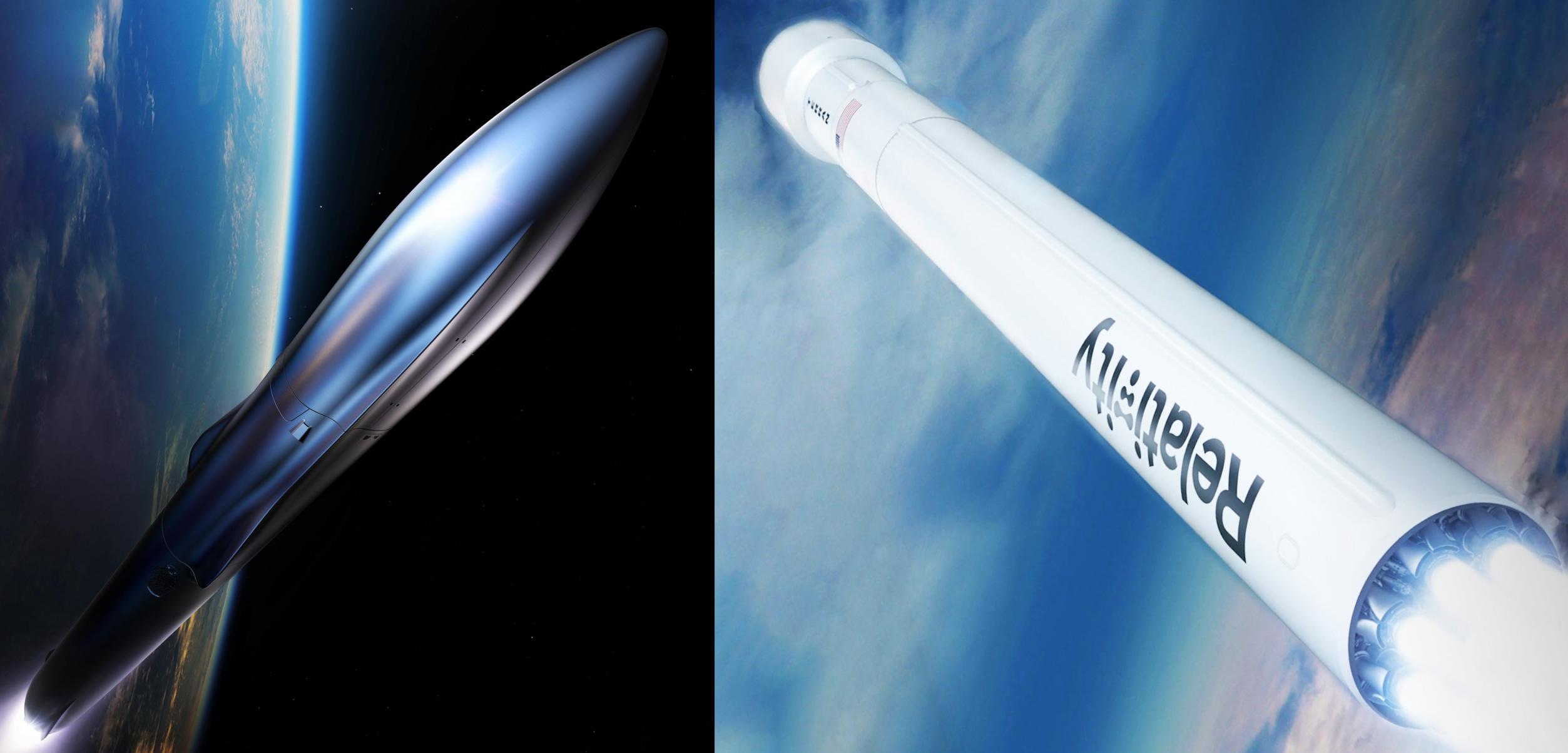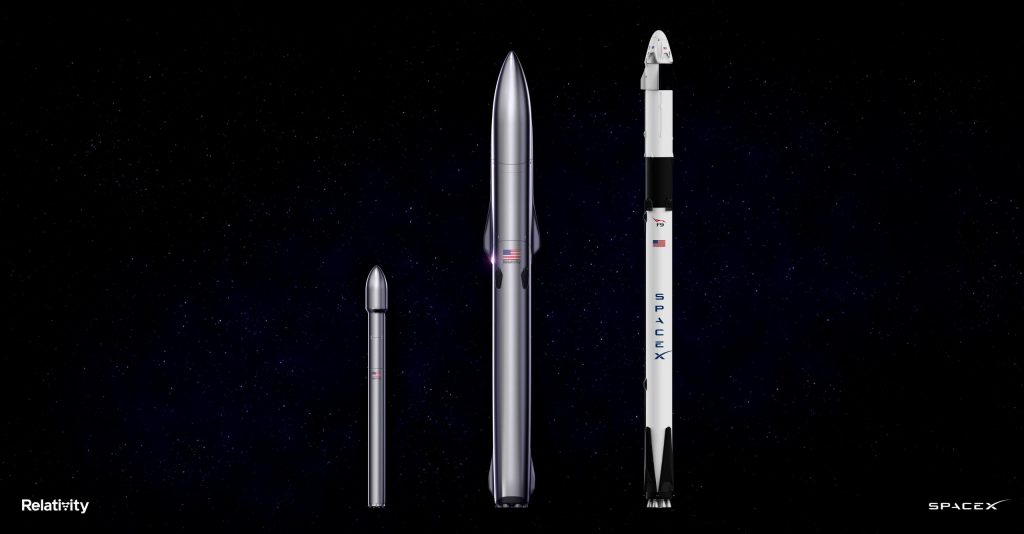

News
Relativity Space reveals plans to rapidly upgrade 3D-printed Terran 1 rocket
Relativity Space has announced that it will only launch the first version of its small Terran 1 rocket a handful of times before upgrading the vehicle in ways that will aid work on a much larger, fully reusable rocket.
Relativity co-founder and CEO Tim Ellis revealed the news in a recent interview, explaining that while the original Terran 1 rocket is still an integral part of the company’s vision and success, it will mainly serve as a bridge to the larger and more capable Terran R – a rare rocket with the potential to compete head-to-head with SpaceX’s Falcon 9.
“We’ve always envisioned Terran 1 being a development platform,” stated Ellis in an interview with Ars Technica. The Terran 1 rocket, which is thrust into orbit using nine proprietary Aeon-1 engines is designed to carry payloads into Low Earth Orbit (LEO). The first launch of Terran 1 is anticipated to take place by the end of 2022, with Ellis stating that Relativity is “definitely launching this year.” Terran 1’s first launch won’t carry payloads, indicating its experimental nature, but it will be serving as the startup’s first orbital launch attempt.
Assuming the rocket’s debut is mostly successful, Terran 1’s second mission will carry a “Venture Class Launch Services” small satellite payload for NASA. The third and final mission for the first version of Terran 1 will also carry payloads, though Relativity has yet to reveal its customer(s).
Once completed, Ellis says Relativity will shift its focus away from the Aeon-1 engine setup on Terran 1’s booster. Instead, they will remove the nine Aeon-1 engines from the vehicle and replace them with a single 135-ton-thrust (~300,000 lbf) Aeon-R engine – seven of which will eventually power Terran R’s reusable booster.
When asked why the startup didn’t simply start with the Aeon-R engine, Ellis noted that developing a booster with nine smaller Aeon-1 engines was “definitely not the optimum choice in hindsight to get to orbit as simply and quickly as possible for the Terran 1 program.” He added, “But it’s been part of our plans to do a much larger reusable rocket for a long time. So we chose to do liquid oxygen and liquid methane engines, as well as the nine-engine configuration on Terran 1 so that we could learn as a company how to do something that complex early on before we had to go build this 20,000-kilogram payload-to-orbit vehicle.”
There are many benefits that come from using the single Aeon-R engine on Terran 1, including reduced cost, processes, and more capable rockets. By scaling down the number of engines from nine Aeon-1s to one Aeon-Rs, they are also scaling down the number of turbopumps, which will reduce labor and cost. The Aeon-R engine, seven of which will power the Terran R rocket, will also produce nearly ~300,000 pounds of thrust. This will provide the company with more capable small launch vehicles.

Ultimately, Relativity’s goal is to launch Terran R, a much larger, more powerful, and (in theory) fully-reusable rocket. Ellis stated that both the first and second stages of Terran R will be reusable, potentially allowing the rocket to directly compete with Falcon 9 – and maybe even the company’s fully-reusable Starship. SpaceX’s workhorse rocket has successfully launched 142 times and the company appears to be more confident in it than ever before. In 2022 alone, SpaceX hopes to launch an average of one Falcon rocket per week.
Despite the fact that SpaceX successfully landed its first Falcon booster in 2015 and reused a booster on a commercial launch in 2017, traditional competitors like Arianespace and ULA have done little to respond and continue to develop new rockets – Vulcan Centaur and Ariane 6 – that are fully expendable, substantially more expensive than SpaceX’s offerings, and still without a clear path to reusability. Alongside Blue Origin’s New Glenn vehicle and Rocket Lab’s Neutron, Relativity’s Terran R rocket may actually be able to compete with Falcon 9.
Ellis further revealed that Terran R already has at least one signed customer, with many others expressing interest behind the scenes. Though the company’s official timeline is incredibly ambitious, Relativity says Terran R could launch as early as 2024, giving the company less than three years to develop the giant rocket from scratch.
It is still unclear how either stage of Terran R will be recovered, nor how the rocket will integrate into the already existing launch facilities being built for Terran 1 at the Cape Canaveral Space Force Station’s (CCSFS) LC-16 pad. Nonetheless, Ellis and the entire Relativity team seem determined to deliver on their promises. Ellis didn’t shy away from bold and undeniable claims, either, stating that “we are definitely launching this year.” “I have no doubt about that…at this point, barring an act of nature or something going seriously wrong in stage testing.”
News
Tesla launches in India with Model Y, showing pricing will be biggest challenge
Tesla finally got its Model Y launched in India, but it will surely come at a price for consumers.

Tesla has officially launched in India following years of delays, as it brought its Model Y to the market for the first time on Tuesday.
However, the launch showed that pricing is going to be its biggest challenge. The all-electric Model Y is priced significantly higher than in other major markets in which Tesla operates.
On Tuesday, Tesla’s Model Y went up for sale for 59,89,000 rupees for the Rear-Wheel Drive configuration, while the Long Range Rear-Wheel Drive was priced at 67,89,000.
This equates to $69,686 for the RWD and $78,994 for the Long Range RWD, a substantial markup compared to what these cars sell for in the United States.
🚨 Here’s the difference in price for the Tesla Model Y in the U.S. compared to India.
🚨 59,89,000 is $69,686
🚨 67,89,000 is $78,994 pic.twitter.com/7EUzyWLcED— TESLARATI (@Teslarati) July 15, 2025
Deliveries are currently scheduled for the third quarter, and it will be interesting to see how many units they can sell in the market at this price point.
The price includes tariffs and additional fees that are applied by the Indian government, which has aimed to work with foreign automakers to come to terms on lower duties that increase vehicle cost.
Tesla Model Y seen testing under wraps in India ahead of launch
There is a chance that these duties will be removed, which would create a more stable and affordable pricing model for Tesla in the future. President Trump and Indian Prime Minister Narendra Modi continue to iron out those details.
Maharashtra Chief Minister Devendra Fadnavis said to reporters outside the company’s new outlet in the region (via Reuters):
“In the future, we wish to see R&D and manufacturing done in India, and I am sure at an appropriate stage, Tesla will think about it.”
It appears to be eerily similar to the same “game of chicken” Tesla played with Indian government officials for the past few years. Tesla has always wanted to enter India, but was unable to do so due to these import duties.
India wanted Tesla to commit to building a Gigafactory in the country, but Tesla wanted to test demand first.
It seems this could be that demand test, and the duties are going to have a significant impact on what demand will actually be.
Elon Musk
Tesla ups Robotaxi fare price to another comical figure with service area expansion
Tesla upped its fare price for a Robotaxi ride from $4.20 to, you guessed it, $6.90.

Tesla has upped its fare price for the Robotaxi platform in Austin for the first time since its launch on June 22. The increase came on the same day that Tesla expanded its Service Area for the Robotaxi ride-hailing service, offering rides to a broader portion of the city.
The price is up from $4.20, a figure that many Tesla fans will find amusing, considering CEO Elon Musk has used that number, as well as ’69,’ as a light-hearted attempt at comedy over the past several years.
Musk confirmed yesterday that Tesla would up the price per ride from that $4.20 point to $6.90. Are we really surprised that is what the company decided on, as the expansion of the Service Area also took effect on Monday?
But the price is now a princely $6.90, as foretold in the prophecy 😂
— Elon Musk (@elonmusk) July 14, 2025
The Service Area expansion was also somewhat of a joke too, especially considering the shape of the new region where the driverless service can travel.
I wrote yesterday about how it might be funny, but in reality, it is more of a message to competitors that Tesla can expand in Austin wherever it wants at any time.
Tesla’s Robotaxi expansion wasn’t a joke, it was a warning to competitors
It was only a matter of time before the Robotaxi platform would subject riders to a higher, flat fee for a ride. This is primarily due to two reasons: the size of the access program is increasing, and, more importantly, the service area is expanding in size.
Tesla has already surpassed Waymo in Austin in terms of its service area, which is roughly five square miles larger. Waymo launched driverless rides to the public back in March, while Tesla’s just became available to a small group in June. Tesla has already expanded it, allowing new members to hail a ride from a driverless Model Y nearly every day.
The Robotaxi app is also becoming more robust as Tesla is adding new features with updates. It has already been updated on two occasions, with the most recent improvements being rolled out yesterday.
Tesla updates Robotaxi app with several big changes, including wider service area
News
Tesla Model Y and Model 3 dominate U.S. EV sales despite headwinds
Tesla’s two mainstream vehicles accounted for more than 40% of all EVs sold in the United States in Q2 2025.

Tesla’s Model Y and Model 3 remained the top-selling electric vehicles in the U.S. during Q2 2025, even as the broader EV market dipped 6.3% year-over-year.
The Model Y logged 86,120 units sold, followed by the Model 3 at 48,803. This means that Tesla’s two mainstream vehicles accounted for 43% of all EVs sold in the United States during the second quarter, as per data from Cox Automotive.
Tesla leads amid tax credit uncertainty and a tough first half
Tesla’s performance in Q2 is notable given a series of hurdles earlier in the year. The company temporarily paused Model Y deliveries in Q1 as it transitioned to the production of the new Model Y, and its retail presence was hit by protests and vandalism tied to political backlash against CEO Elon Musk. The fallout carried into Q2, yet Tesla’s two mass-market vehicles still outsold the next eight EVs combined.
Q2 marked just the third-ever YoY decline in quarterly EV sales, totaling 310,839 units. Electric vehicle sales, however, were still up 4.9% from Q1 and reached a record 607,089 units in the first half of 2025. Analysts also expect a surge in Q3 as buyers rush to qualify for federal EV tax credits before they expire on October 1, Cox Automotive noted in a post.
Legacy rivals gain ground, but Tesla holds its commanding lead
General Motors more than doubled its EV volume in the first half of 2025, selling over 78,000 units and boosting its EV market share to 12.9%. Chevrolet became the second-best-selling EV brand, pushing GM past Ford and Hyundai. Tesla, however, still retained a commanding 44.7% electric vehicle market share despite a 12% drop in in Q2 revenue, following a decline of almost 9% in Q1.
Incentives reached record highs in Q2, averaging 14.8% of transaction prices, roughly $8,500 per vehicle. As government support winds down, the used EV market is also gaining momentum, with over 100,000 used EVs sold in Q2.
Q2 2025 Kelley Blue Book EV Sales Report by Simon Alvarez on Scribd
-

 News3 days ago
News3 days agoTesla debuts hands-free Grok AI with update 2025.26: What you need to know
-

 Elon Musk1 week ago
Elon Musk1 week agoElon Musk confirms Grok 4 launch on July 9 with livestream event
-

 Elon Musk5 days ago
Elon Musk5 days agoxAI launches Grok 4 with new $300/month SuperGrok Heavy subscription
-

 News2 weeks ago
News2 weeks agoTesla Model 3 ranks as the safest new car in Europe for 2025, per Euro NCAP tests
-

 Elon Musk2 weeks ago
Elon Musk2 weeks agoxAI’s Memphis data center receives air permit despite community criticism
-

 News5 days ago
News5 days agoTesla begins Robotaxi certification push in Arizona: report
-

 Elon Musk2 weeks ago
Elon Musk2 weeks agoTesla reveals it is using AI to make factories more sustainable: here’s how
-

 Elon Musk2 weeks ago
Elon Musk2 weeks agoTesla scrambles after Musk sidekick exit, CEO takes over sales
















